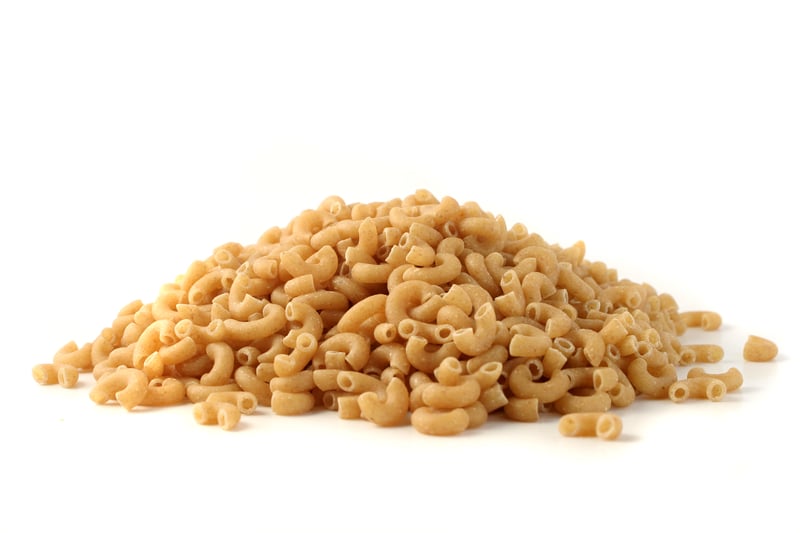Ask The Coaches: Is Whole Wheat Pasta Healthier For You?

But recently, I served up one of my favorite pasta dishes (using whole-grain pasta, of course), and a friend couldn’t believe it. She said there’s no difference between eating whole-grain and white pasta, so why bother? Especially since regular pasta (in her opinion) tastes so much better. If I’m trying to eat healthier, should I go for pasta alternatives instead?
Is she right? Is there really NO difference between regular pasta and whole-wheat pasta? Is whole-wheat pasta healthy? I need real facts to support my decision!
Thanks for your help,
– Pamala
A: Pamala, thanks for reaching out to us with your most excellent question. The “rule” of navigating past the white has been a helpful guideline for many people, as they seek to eat less refined foods, reduce sugar, and eat more whole foods instead.
However, while white foods have been given a bad reputation, just because a food is white doesn’t mean it’s unhealthy. There are many healthy foods that are white, such as cauliflower, potatoes, Greek yogurt, whey protein, bananas, onions and more. Yet, you are correct that it’s much healthier to eat minimally processed, whole grains instead of those that have been overly processed and refined.
What is the Difference Between Whole-Wheat and Regular Pasta?
All pasta is high in carbs and, if it’s made from wheat, also contains gluten, so if you’re cutting back on carbs or are gluten-sensitive, then all wheat pasta—including whole wheat—is off the menu. That doesn’t mean pasta is inherently unhealthy, though.
Pasta does provide nutrients as it’s typically made from durum wheat, water, and eggs. Pasta comes in a wide variety of shapes, including rotini, spaghetti, elbow, and shells, among others and can also be made from other grains, such as quinoa, rice, buckwheat, barley, and even beans or lentils.
When looking at regular vs. whole-wheat pasta, the biggest difference comes down to processing. Whole-wheat grains provide all three parts of the grain: the bran, which covers the outside; the germ, which sprouts from the seeds; and the endosperm, or the starchy center of the grain.
To create regular (i.e., white or refined) pasta, manufacturers turn up the heat to refine the grains, forcing the bran and germ out, leaving just the endosperm to create the light beige (i.e., white), fluffy pasta many of us are used to seeing.
This stripped-down grain means that the end product will have a longer shelf life, a lower price tag, and yes, it is stripped of some of its nutrients as well. 1 While many of the nutrients are removed during processing, some can be added in if the product is “enriched.” Enriched pasta just means that removed nutrients, like B vitamins and iron, are (synthetically) added back in.
Whole-grain pasta, which leaves the whole grain intact, provides:
- More fiber (6 grams in 1 cup of whole-wheat spaghetti vs. 2.5 grams in refined spaghetti)
- More healthy fats
- More protein
- Fewer carbs (37 grams vs. 43 grams)
- More vitamin E and B vitamins (though this can change if the pasta is made with enriched flour), antioxidants, and phytochemicals 2
- More minerals like manganese, selenium, copper, phosphorus, magnesium
- Fewer calories (e.g., whole-wheat spaghetti provides 174 calories vs. 220)
Some research has even found that when whole grain pasta replaced its white cousin, it leads to decreased appetite along with greater feelings of fullness, 3 which makes sense just looking at the fiber content. Other studies, though, have found mixed results. And some have found no difference in blood sugar after consuming either refined or whole-grain pasta.4
Is Whole-Grain Pasta a Better Option?
On some levels, the answer appears to be absolutely yes. It provides more fiber, vitamins, and minerals.
Is it a good choice? That may be more difficult to answer. You see, whole-grain pasta is made from whole-wheat flour that has been pulverized to create smaller, more easily digested particles. This explains why whole wheat and refined pastas both lead to similar increases in blood sugar. 5
So, even though it does provide fiber, it’s not nearly as beneficial as eating intact whole grains as you would when eating oats, quinoa, corn, or even whole wheat or barley. That said, if you don’t want to give up wheat flour for another alternative, whole-wheat pasta does have a slight edge as it does provide more fiber to keep you full and fewer calories than its refined counterpart.
Just remember to eat pasta in moderation as the carbs and calories can add up quickly. It’s easy to fill up a full bowl of pasta, which is typically a double to triple serving.
How to Prepare Whole-Grain Pasta?
Because regular pasta is made from refined flour, it has a lighter, fluffier texture. Whole-grain pasta tends to be heartier in flavor and texture—some would even call it grainy or more like chewy cardboard than regular pasta. So, if you aren’t used to it, it can take some time to adapt.
However, making your whole-wheat pasta enjoyable can also depend a lot on how it’s prepared. You see, whole-wheat pasta doesn’t cook like regular pasta, and if you expect it to, you’ll likely be disappointed by the end result.
It takes longer to cook, for example, and it doesn’t always pair as well with a simple red sauce topped with Parmesan cheese. You may also want to try different varieties of whole-wheat pasta as there’s a surprising amount of variety between brands.
To make your whole-wheat pasta even better:
- Because whole-wheat pasta can absorb water differently and cook at a different rate than refined pasta, be ready to take a bite to determine when it’s done. It’s easy to overcook and make mushy, but it’s just as easy to undercook and leave chewy.
- Start checking a bit earlier than the directions recommend. For example, if it says 12 minutes, start checking around 8 minutes. Let taste be your guide to determine when it’s perfectly cooked.
- Toss your pasta with a stronger, earthier sauce, like a pesto, or with dark leafy greens like chard or kale, roasted vegetables, or exotic mushrooms.
- If you want a cold pasta salad, after adding your usual olive oil, brighten the flavor with a squeeze of lemon juice or a splash of vinegar.
- Go heavy on the spices and flavors, as whole-wheat pasta can take more complex flavors like chili flakes, garlic, bacon, and even jalapeños.
- Try a creamy sauce like Coach Cristina’s cauliflower alfredo or a chucky, more robust sauce made with tomatoes, squash, and bell peppers.
Thanks again for your question, Pamala. I hope this information helps!




 7 Signs Your Body is Seriously Low on Collagen (not just wrinkles)
7 Signs Your Body is Seriously Low on Collagen (not just wrinkles) Health Expert: "Turmeric Doesn't Work (unless...)"
Health Expert: "Turmeric Doesn't Work (unless...)" 3 Warning Signs Your Probiotic Supplement is a Total Waste
3 Warning Signs Your Probiotic Supplement is a Total Waste

